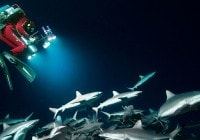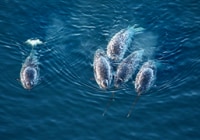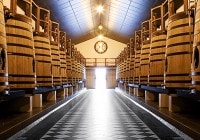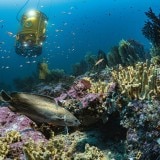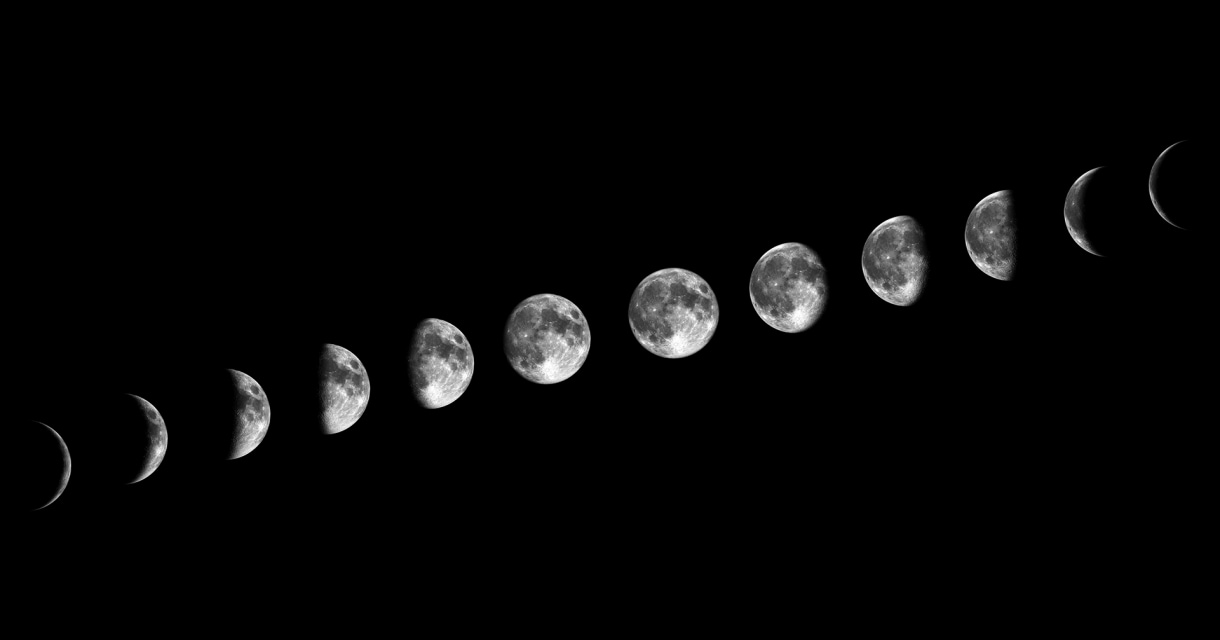
Search in Issues
Chapters
List of parts
Chapter 3
THE “GROUPER MYSTERY”
A 24-hour dive dedicated to science and understanding.

And it is when actually saying it that I evaluate the extent of my folly: I AM REALLY GOING TO DIVE FOR 24 HOURS.
It’s the story of a scientific adventure and diving record in a remote Polynesian paradise. A place where thousands of camouflage groupers, followed by hundreds of sharks, congregate in secret once a year. Laurent Ballesta’s team wanted to gain a better understanding of what pushes these fish to wait for the exact day of the full moon to reproduce simultaneously! With the help of researchers from the CNRS in Moorea, they made numerous dives and conducted many experiments to study and testify to this unique phenomenon. Taking advantage of this incredibly rich period, Laurent Ballesta made a record 24-hour dive.
It is 3 p.m. and the sun is shining over the turquoise water. I’m sitting on the pontoon of a semirigid boat and I am preparing to dive for 24 hours. For the first time in my life, before getting in the water, I can call out “Cheers and see you tomorrow” to my mates.
And it is when actually saying it that I evaluate the extent of my folly: I am really going to dive for 24 hours, and I will not emerge from the water until the same time tomorrow. I am completely determined. I have been dreaming of this for so long. But I am also disconcerted. I am afraid. Afraid of not succeeding, of being cold, of being hungry, of wearing myself out too quickly and wanting to get out before the end. I have been doing “committed” dives (meaning deep ones) for years, but today is different. It is no longer a vertical exercise, but a horizontal test. It is no longer just adive, it’s a marathon! I reassure myself by thinking that my doubts will only last for a while. In a few hours’ time, the question will no longer be relevant, since by then it will be impossible ascend at will: the mixture that I am breathing will have saturated my blood with helium. Even at a depth of 20 m, it would take me six hours to reach the surface if I had the misfortune to give up. A final glance at the members of my team and I roll backwards. The twice-round-the-clock epic has begun.
Nothing is more essential than time when it comes to solving the “grouper mystery”. It’s a mystery that is both subtle and complex. What I am hoping to witness is the rendezvous of all camouflage groupers (Epinephelus polyphekadion) around the Fakarava atoll, 490 km northeast of Tahiti. Their gathering takes place in this unique location that links the lagoon to the ocean: a pass that forms a break in the coral barrier reef, a tiny gate between the vast lagoon and the largest ocean in the world. In this indentation, the currents are violent but predictable: they follow the tide and the lagoon, alternately filling and emptying every six hours. The animals live according to this rhythm.
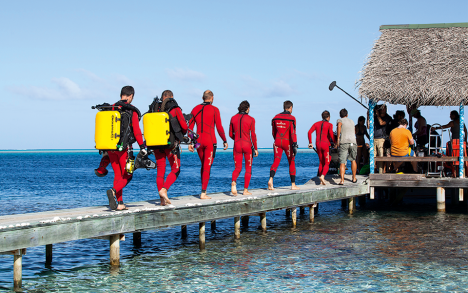
The full moon is finally here, the day that the groupers are supposed to reproduce. The team heads for the boat for the last dive of this long mission, mentally prepared for their four to six-hour stint under water.
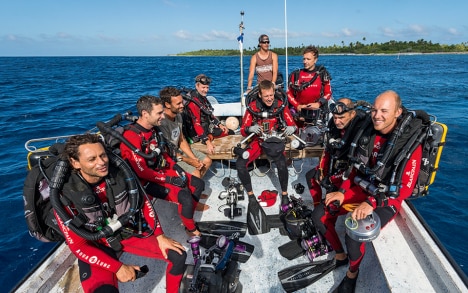
A few minutes before entering the water, the team, true to form, conceals its concentration with jokes and official photo sessions! But the equipment is ready and motivation running high.
Intense living like nowhere else, amid cohabitation arrangements that are not always simple. To live here is as beneficial as it is dangerous: to eat without being eaten, to brave the predators in order to reproduce. The pass accelerates all processes. The size of two or three football fields, this area is sheer concentrated ocean. A canyon paradise, and a trap for groupers with the mass arrival of gray reef sharks. Why come here to breed? The pass is shaped like a funnel, ideal for an ambush. In fact, the groupers have no choice: they come in search of the only current that is powerful enough to disseminate their eggs into the ocean, in exactly the same way that flowers need wind to disseminate their pollen.
I have always been convinced of a very simple fact: to understand marine life, one needs to take the time for lengthy, uninterrupted observation. So I dream of setting off to dive in the same way that a botanist heads for the forest, for lengthy periods, and covering many kilometers. The objective is quite simply to observe, not to set a physical resistance record. The success of this project lies in facilitating the endeavor and proving that a new method exists to enjoy longer dives than any fit diver could in turn undertake.
My friend Jean-Marc Belin worked for a year in order to solve the problem that these 24 hours at more than 20 m create for me: decompression. Theoretically, at the end of the 24 hours, I will need an additional 20 hours to ascend to the surface, thus a total of nearly two days spent under water. The exercise becomes feasible if one breathes something other than compressed air. Jean-Marc has chosen an extreme mixture of gases: 87% helium and 13% oxygen. This cocktail will gradually dissolve in my body throughout the dive, without the oxygen damaging my lungs. The downside is that this precludes any emergency exit. After 18 hours of diving, the helium simply needs to be replaced with air. By doing this, I’ll start my decompression but without changing depth, so I won’t need to ascend immediately and I’ll be able to continue the exploration. That is the clever part of Jean-Marc’s system.
But I’m nowhere near that stage yet. I’ve only been under the water for three hours observing schools of groupers: the largest ever gathering to date, comprising 18,000 of them. It is 6 p.m. and the light is fading. On the surface, the sun must be setting. It won’t be long before my buddies join me for the first resupply. I am meeting them in a prearranged location, because I need to recharge my rebreather which does not have sufficient capacity for 24 hours. Antonin comes down to take my rebreather and bring it back to me—filled— as fast as possible. Meanwhile, I wait for him on the bottom using a spare rebreather. Everyone has their quirks and mine is that to me: my own rebreather is like an old pair of sneakers. One is comfortable inthem and has no desire to change, especially not when it comes to a long hike.
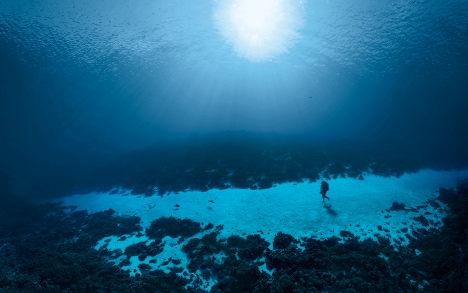
In the middle of Fakarava’s southern pass, a strip of sand swept by the current, where it feels good to just succumb to the pleasure of walking.

It’s the edge of the pass on the ocean side and the diver is 30 m below the surface with an almost vertical slope which drops around 2000 m...
The current can get up to two knots when the tide is at its height, while the camouflage groupers line up facing the current, each week more numerous than before, awaiting the D day for breeding.

NIGHTTIME IS THE KINGDOM OF CRUSTACEANS AND MOLLUSKS. In Polynesia, there are more than 5,000 species.
The resupply operation went perfectly, at least from my perspective. Later, I will learn that they’d had a pretty frantic time of it on the surface when it came to recovering the equipment, what with the current and the already well ensconced pitch-dark night.
It’s nighttime and I have 12 hours of night ahead of me. My buddies will come one after the other, Cédric, then Manu, Antonin and finally Cédric again. In turn, they will each spend three hours keeping me company by hovering 10 m above me with a powerful light. They light up my path and I see it as a great token of friendship. I owe them this magical vision, this indiscreet skylight on the little secrets of nocturnal life.
The fish have changed color. They have truly donned their pajamas, given the incredible difference in their livery from day to nighttime. Hour after hour, I add to my personal bestiary of nocturnal creatures. Nighttime is the kingdom of crustaceans and mollusks. In Polynesia, there are more than 5,000 species. Invisible by day, they wait for dusk to emerge from the bowels of the coral. Cautious, they remain on the threshold.
At the slightest glimmer, they plunge back into this overpopulated “crypt” of the coral reef. I have but a brief moment to capture a picture of them as they flee from the light.
The night continues, and I have already roamed 7 km along the reef, a long loop that brings me back to the refueling meeting place for a second time. It is midnight and I await the relief. It’s all going well and I’m not cold, but I am impatient. I learned that a diver recently set a record in Egypt by remaining under water for 55 hours, at a depth of 5m, sitting on the sand near a beach, without moving and connected to bottles on the surface by a long umbilical cable. I actually suspect that he took sleeping pills to make the time pass faster. For my part, I’m trying to extend the time!
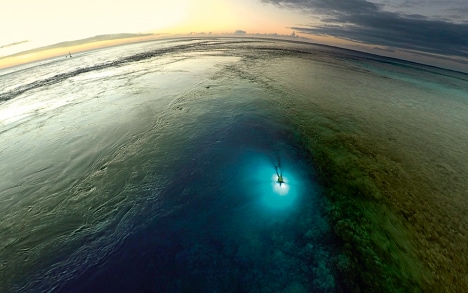
Seen from the sky, the sun sets on a small piece of the southern pass of Fakarava, on the lagoon side, where the canyon narrows and the current accelerates, resulting in countless whirlpools on the side of the pass.
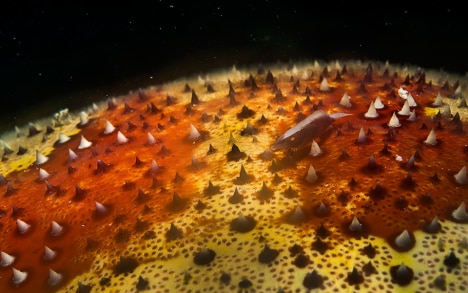
The little Periclimenes shrimp lives on the skin of the cushion starfish. It is found between the quills of the star and the respiratory papulae, which provide both board and lodging.
Midnight, and the groupers have already been asleep for six hours. They are hidden wherever possible, as they are able. There are so many of them that there are not enough crevices in the reef to shelter them all. And the sharks are patrolling. Johann, a shark specialist, has made repeated counts nearly every day since our arrival. He thinks that there are nearly 700 in the pass. The water is electric. During the day, the shark is calm and rests in the current. He knows all too well that the groupers are too quick. The shark awaits his moment after nightfall when the groupers are forced to rest a little. The sharks are no longer in open water. They have come down and swarm along the seabed in their hundreds. Their agitation bothers me, doubtless because I know that tonight I cannot ascend whenever I want. It’s stressful but, above all, it’s a show. I realize how much their speed is underestimated by day. By night, my gaze can barely keep pace with their spurts of speed. Many of us think we understand the hunting behavior of sharks from mock attacks during chumming sessions using bait. This seems so naïve to me today. It would be like pretending to understand wolves hunting in packs because a dog has been given its food bowl.

Night has fallen and the sharks have left the open water. Currently they are swarming on the bottom to track down the groupers. Because there are too many of them, there is not enough space for them all to hide in the reef.
THEY DEVOUR THE GROUPERS IN HUNDREDS, PERHAPS IN THOUSANDS: another factor that further deepens our “grouper mystery”.
Yanick has joined me for a few hours with his special slow-motion Phantom camera that is capable of taking 1,000 images a second. A violent and chaotic frenzy explodes before him. But the same scene, when watched in slow motion, will later show us all the efficiency and precision of the sharks’ attack. They devour the groupers in hundreds, perhaps in thousands: another factor that further deepens our “grouper mystery”. It would appear that the gathering nonetheless works, that this breeding ground is worth it despite the risks, and that the groupers have managed to solve the equation between sacrifice and benefit to their advantage. We are keenly aware that these hunting scenes filmed in slow motion, as well as these photographs that freeze the dazzling speed of the attacks, are all unprecedented images. Like me, my companions are exhilarated. As if we had transgressed a taboo: diving in the pass by night when the sharks are hunting.
During the night, the sharks make contact incessantly. My slightest movement and the slightest ray of light attract them. Initially just one excited representative, then two, then ten, and then they vanish as quickly as they appeared and the carrousel begins all over again. I even recognize individuals, because it is often the same ones that react. All make a beeline for me but although some make contact without ever opening their mouths, most turn around without touching me. In the end, when I get out of the water the next day, I barely notice two or three bruises on my thighs.
It is 6 o’clock in the morning. On earth, we say the day is breaking when, far away on the horizon, the light gradually ascends. Here, the light descends. In the small hours, it filters gently in from above. A dim glow pours blue-tinged water into the inky black depths. It is 6 o’clock and the bells are ringing. At least that is what comes to my mind all of a sudden, at the very moment when the light reappears and I hear whales singing! I unfortunately do not get to see them and maybe they are hundreds of kilometers away, but they sing for us. Who else would it be for after all? I have no idea if one can have goosebumps under a 7-mm-thick wetsuit but that’s still what it feels like.
It’s time for the final resupply. Sané, the Polynesian who has lived here for twenty years, has come for a little morning visit. With a naughty smile, he proffers the toothpaste tube and a toothbrush. I share his game happily and do the necessary without swallowing a mouthful of water. The night is over, along with much of the stress and I only have nine hours left in which to enjoy the surprises of the southern pass seabed. But it is nevertheless a critical moment: watched by Jean-Marc, I replace 87% of the helium with air. I am not at all dizzy, everything’s fine. This operation marks the beginning of my decompression but not the beginning of the ascent. I can remain at 20 m the entire morning.
The sharks have calmed down and the groupers are beginning to stir. Some resume their lethargic swimming, others their hysterical struggles. This morning, after spending a whole night in their presence, they look like survivors to me. Twenty-four hours down here is an opportunity to bear witness to a touching sight and to put together a tragic gallery of portraits,
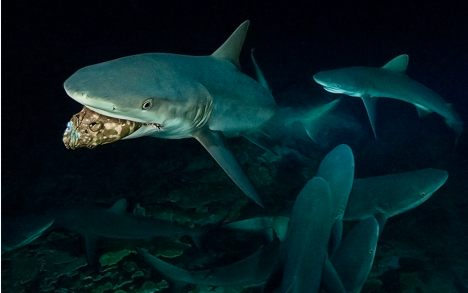
Around 350 kg of fish are devoured by the sharks every night. How many groupers is that at the end of the breeding season?
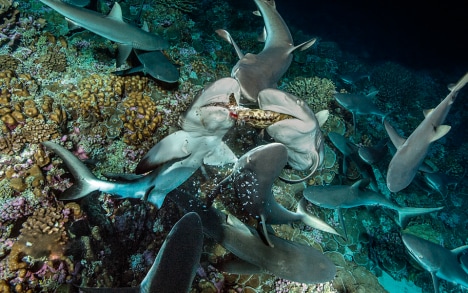
The groupers are sometimes fairly large and can weigh several kilos, so a gray shark will struggle to swallow it in one bite. The other sharks know and this results in frequent frenzies breaking out because, even if this only lasts a fraction of a second, they all hope to have a piece of the pie.

They are so excited that the sharks jostle, break and reduce whole chunks of the reef to powder when the presence of a grouper becomes apparent, even hidden between the coral.
a collection of gravely injured soldiers, miraculous survivors bearing the stigma of these nocturnal raids. The wounds are deep, with fins and gill covers torn off revealing raw gills. But nothing appears to be able to stop them. Even in their sorry state, they proclaim their determination to reproduce, and challenge each other again and again. Being near them makes me think that the reproductive act here is no longer a reward but a sacrifice. These fish are not the masters of their own destiny, they are slaves to their own instinct.
The current reverses one last time and begins to enter the lagoon, as I let myself be swept along on it. It is almost 3 p.m. and the adventure is nearly over. I have been under water for more than 23 hours. My teeth hurt because of the mouthpiece that has injured my gum, but I feel good. The final minutes are approaching but I am in no hurry for it to be over.
I move closer to the surface once again, and my buddies dive to meet me. By now I am at last really keen to be out of the water. I want to join them, to talk with them, to laugh with them. I already know that in a little while, everyone will have something to say. Around the table, everyone will want to recount every detail of this strange day in their own way, through successive burlesque slapstick-comedy one-man shows serving to disguise our pride. A little later still, we’ll undoubtedly raise our glasses in the name of friendship and the sea, while laughing boisterously as a diffident way of digesting these overly painful emotions. In the name of friendship and the sea, I know that our gazes will barely cross, no longer out of modesty but from a sense of caution, because there are certain values that transport you to such heights they make you dizzy if you open your eyes.
A day of rest has gone by since the 24-hour dive. Galvanized by this very recent experience, bonded more strongly than ever by this collective success, my team and I have never sensed such a surge of enthusiasm and solidarity. That’s just as well because it’s not yet over: the full moon is finally here, the day that the groupers are supposed to reproduce. From the first minutes of this final dive, one thing appears to be obvious: the ecosystem has changed. The fusiliers, a type of tropical sardine, have appeared in their tens of thousands.
THE FULL MOON IS FINALLY HERE, the day that the groupers are supposed to reproduce.
I have never seen this many since our arrival. They too know that something is going to happen. The groupers’ excitement is also unusual, but after weeks of confrontations, a certain spatial organization has set in. This natural work of art is no longer abstract: the canvas now begins to make perfect sense. Firstly, the females in camouflage dress and with their bellies dilated with eggs, either near the seabed or sometimes even resting on it, and just above them the pale gray males, watching over them from above. A male regularly goes down to a female, and begins a parade consisting of delicate tremors and then very fast, he jostles her, always in the same way, by biting her stomach, undoubtedly to induce spawning, a phenomenon that appears to be imminent!
And suddenly, it’s all happening! Bands of groupers shoot upwards and the reproduction has well and truly begun, although unfortunately too far away and too fast for us to be able to get a good view of the intimate details. The fusiliers, of which there are more and more, block out the horizon so effectively that it is hard to make out the groupers. The cloud of eggs and semen barely has a chance to appear before the fusiliers rush to swallow the fertile milt.
Pandemonium reigns at the bottom of the pass. The groupers leap here and there, taking off all around us like live fireworks, while the fusiliers are everywhere and the sharks plunge into the fray but re-emerge empty-handed most of the time. The act lasts less than a second and we don’t even have time to understand what is happening. Two things however appear certain: it is always a band of a dozen or so groupers that leap from the seabed, never a single couple; and it is anarchy, the laws of survival of the fittest or fastest, that appears to prevail.
And it is precisely that which surprises me. What is the use of fighting for four weeks if the winner is not then entitled to a female all to himself? It’s a complete waste of energy! What is the use of coming so early in the season with the risk of being eaten every night if it doesn’t offer any form of privilege on breeding day? I don’t understand. The “grouper mystery” remains intact. Weeks of fighting, but when it comes to breeding, no rules appear to apply: all the males, winners and vanquished alike, leap towards the female laying her ova and all appear to have the same chance of fecundating her. Only the ocean currents, which blend this fertile soup, will decide who will be paired with whom. Will the happy sire be chosen by fate? I can’t believe it. This truly is the crux of the “grouper mystery” and something has definitely escaped us. But how can we possibly have any idea? The mating is so quick, although one can definitely understand the speed factor: to avoid the sharks when they ascend to the open water and also to be the first to fertilize the female’s eggs. But perhaps this speed hides another truth from us.
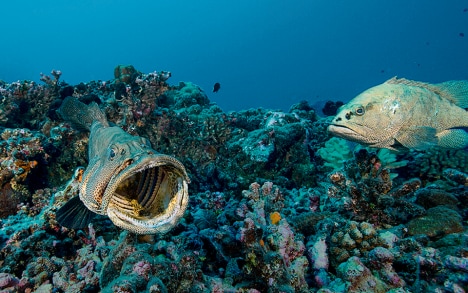
A yawn, possibly between two battles, which shows the groupers’ immense mouth, and the small teeth on its jaws.
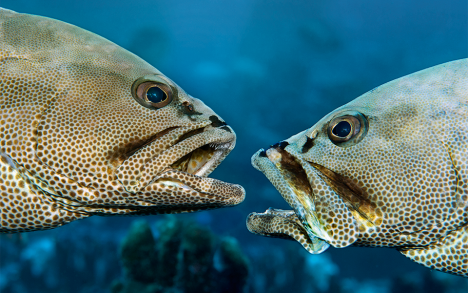
The groupers face each other down (they have binocular vision which enables them to see reliefs); they can remain face to face for several minutes before actually attempting to bite at such speed that a diver frequently only sees a cloud of torn off scales somersaulting before his mask...
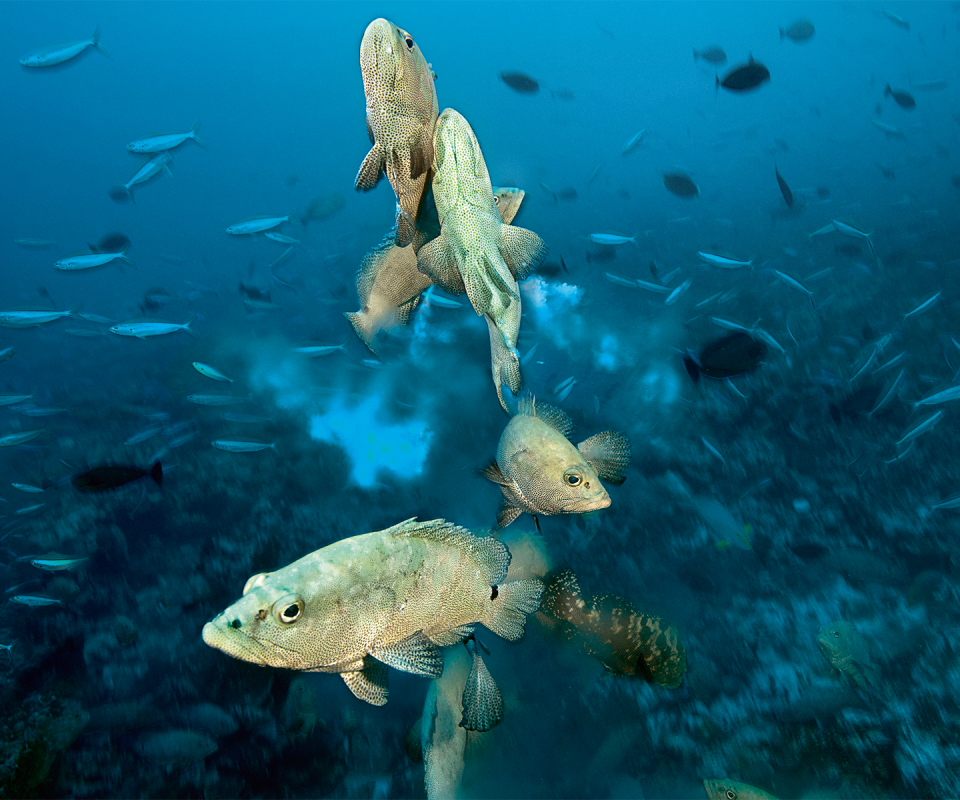
This only happens on one day a year and it’s today: the groupers leap from the bottom to breed. The female has laid her eggs and she is already on her way back down when an entire group of opportunistic males take their chances and inundate the scene with their semen.
Once again, Yanick manages to be in the right place at the right time. He triggers his special camera bang onto a stupendous breeding session, a moment of life lasting but a single second, but a second that will later become 40 seconds with the magic of slow motion. And in slow motion, everything becomes clear: it is obvious that in fact just one single male starts the round with the female, holding her body to body as long as he can. Admittedly, he hasn’t earned exclusive rights, only a chance to be first in line, because the other males are already converging on the couple. This privileged being is the dominant male whose status is the hard-won prize after four weeks of bitter battles. And he enjoys only the benefit of this short lead that enables him to sate himself before the other opportunistic males take their chances by inundating the stage with their semen, but a microsecond too late.
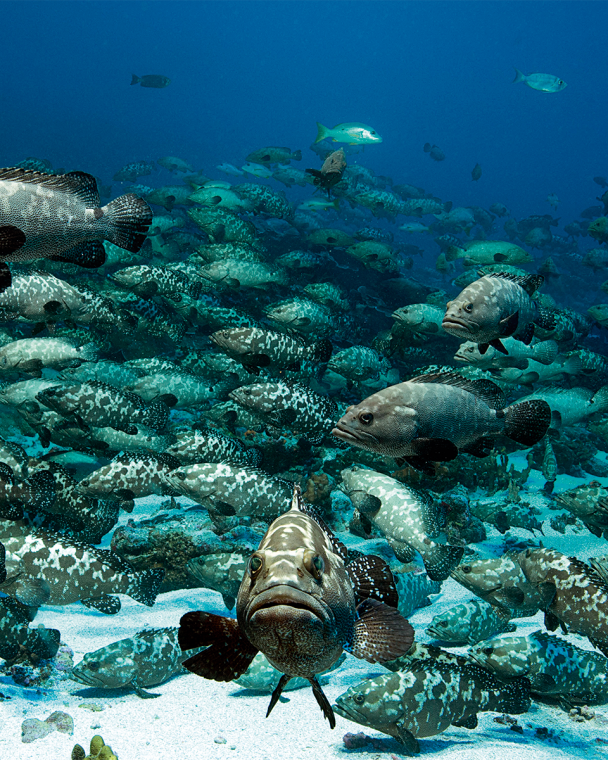
The count in 2014 revealed a number totaling 18,000 groupers. In 2015, Laurent returned to the location and there appeared to be even more. In 2016, the entire team will attempt a new expedition and who knows how many groupers will be there this time?
So that was the key to understanding the “grouper mystery”: a chance to observe the inner workings for a fraction of a second and discover, thanks to slow motion, the existence of a respected if fleeting hierarchy, evidence of a meticulous organization, albeit invisible to the naked eye. I spent 24 hours under water when in fact everything became clear in a fraction of a second! I like to think it was necessary, that one should take time if one wishes to capture the moment.
We have naturally not yet grasped everything. How could one even profess to, with an event that can be observed only once a year? Only one thing is certain, and that is that each year from now on, when it is full moon, we will also want to return. Starting next year, and then in ten, twenty and forty years’ time. Because in these biodiversity hotspots, ecological studies only make sense if they are repeated and continued from year to year. The stats collected during this expedition will only have any value if they are compared with future figures. Seven hundred gray sharks, 18,000 groupers, but how many will there be in twenty years? The southern pass of Fakarava is classified by UNESCO as part of a biosphere reserve, but will it nevertheless escape the ecological crises of the 21st century? In the other big atolls of Polynesia, these annual gatherings of groupers also existed in the past. Today, they have all disappeared.
--------------------------------------------
It is the Fifty Fathoms, the first modern diving watch, which established Blancpain’s intimate connection to the ocean. This timepiece earned its place as one of the key developments in the overall history of scuba diving and ocean exploration. Its prominence in the opening up of the underwater world established ties between Blancpain and leading scientists, underwater pioneers, environmentalists, underwater photographers and others who have dedicated their lives to the ocean.
From these ties, Blancpain has come to understand the critical importance of preserving and protecting the world’s oceans.
And Blancpain has become a fervent supporter of ocean protection initiatives.
We call our efforts in furtherance of this cause the “Blancpain Ocean Commitment” and this commitment has been manifest through our backing of and partnerships with leading organizations and their projects, including Laurent Ballesta’s Gombessa Expeditions. Blancpain is proud to have sponsored both of the Gombessa Expeditions which have produced the dramatic findings chronicled in issues of Lettres du Brassus.

Other issues
Don't miss the latest issue
Sign Up for New Releases



